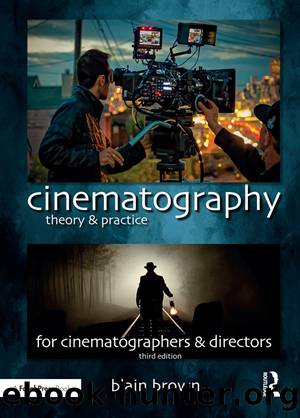Cinematography: Theory and Practice by Brown Blain;

Author:Brown, Blain;
Language: eng
Format: epub
Publisher: Taylor & Francis Group
ANOTHER APPROACH
Just bending and stretching the knee and shadow areas can achieve a good deal but in the end, it is a limited approach and can result in some images that look a bit unnatural. Over the years, camera manufacturers have come up with even more sophisticated ways of extending the dynamic range of video cameras.
HYPERGAMMA/CINEGAMMA/FILM REC
Manufacturers have several versions of gamma encoding variously called Hypergamma, Cinegamma, Video Rec, Film Rec, or low contrast curve, which are designed to extend the dynamic range of the camera (Figures 10.17 and 10.18). These gamma curves are usually measured in a percentage, with the range of Rec.709 as a base 100%, with typical settings of 200%, 300%, 400% and so on. The higher the dynamic range, the greater the highlight value that can be captured. For example, 400% means it can capture a highlight that is 4X (two stops) higher than 100% reflectance. Using these curves can make the use of exposure aids such as zebras difficult.
Figure 10.18. (left) Panasonic’s Film Rec curves. They are denoted as the percentage by which they extend the dynamic range.
Download
This site does not store any files on its server. We only index and link to content provided by other sites. Please contact the content providers to delete copyright contents if any and email us, we'll remove relevant links or contents immediately.
The Kite Runner by Khaled Hosseini(4431)
Gerald's Game by Stephen King(3918)
The Perils of Being Moderately Famous by Soha Ali Khan(3782)
Dialogue by Robert McKee(3582)
Story: Substance, Structure, Style and the Principles of Screenwriting by Robert McKee(2984)
The 101 Dalmatians by Dodie Smith(2935)
The Pixar Touch by David A. Price(2739)
Confessions of a Video Vixen by Karrine Steffans(2673)
Fantastic Beasts: The Crimes of Grindelwald by J. K. Rowling(2543)
How Music Works by David Byrne(2525)
Harry Potter 4 - Harry Potter and The Goblet of Fire by J.K.Rowling(2416)
Slugfest by Reed Tucker(2415)
The Mental Game of Writing: How to Overcome Obstacles, Stay Creative and Productive, and Free Your Mind for Success by James Scott Bell(2393)
Wildflower by Drew Barrymore(2117)
Scandals of Classic Hollywood: Sex, Deviance, and Drama from the Golden Age of American Cinema by Anne Helen Petersen(2109)
Casting Might-Have-Beens: A Film by Film Directory of Actors Considered for Roles Given to Others by Mell Eila(2071)
Screenplay: The Foundations of Screenwriting by Syd Field(2056)
Robin by Dave Itzkoff(2005)
The Complete H. P. Lovecraft Reader by H.P. Lovecraft(1976)
